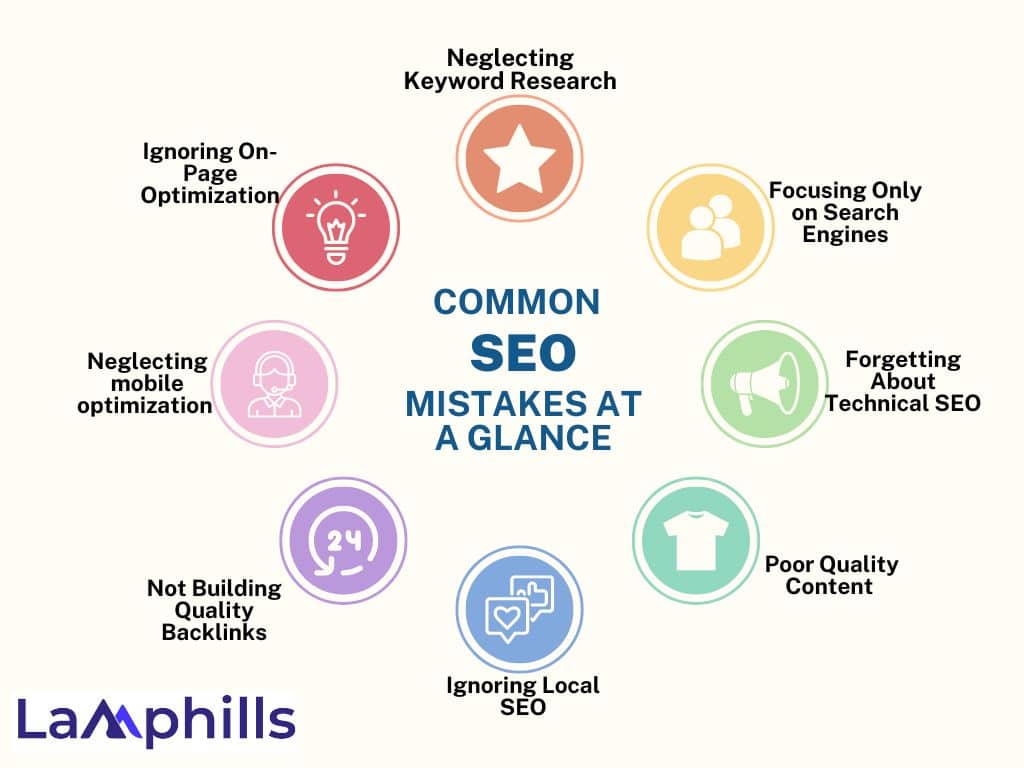When it comes to getting your website noticed online, avoiding common SEO mistakes is crucial. Especially if you want to excel in digital marketing and its ever-changing trends, search engine optimization (SEO) is key to bringing visitors to your website. A good SEO plan can greatly improve your online visibility and raise your website’s rankings on search engine results.
However, many website owners and marketers make common SEO mistakes that can hurt their efforts and limit their success. In this guide, we will walk you through the most common SEO mistakes with practical measures to avoid them, helping you get the most out of your website and achieve lasting success.
Key Points
- Failing to conduct thorough keyword research can lead to using overly competitive keywords, causing the website to get lost in the crowd.
- Skipping on-page SEO elements such as meta titles, descriptions, and header tags can result in content that is not optimized for search engines, despite being informative.
- Over-optimizing for search engines without considering the user experience can lead to content that is keyword-stuffed and less engaging, increasing bounce rates.
- Not optimizing a website for mobile devices can result in poor user experience, slow loading times, and difficulty navigating, leading to lower search engine rankings.
- Overlooking technical aspects such as site speed, secure connections (HTTPS), and proper site structure can hurt search engine rankings, even with good content.

A few months ago, my friend, an SEO expert, came to me upset about an online marketing campaign she was running for her client’s boutique. Despite her efforts to drive traffic and improve the boutique’s online presence, the results were disappointing. The website traffic didn’t increase, and their search engine rankings stayed the same.
We looked closely at her SEO practices and found that many weren’t done. This made me realize that these mistakes can still happen no matter how experienced someone might be in SEO. They might seem simple, but if missed, the results can be harmful and sometimes even crash the website.
SEO, or search engine optimization, is getting more unpaid visitors to a website by making it appear better in search engine results. You need SEO techniques to get your website to rank high for your chosen keywords.
Even though there are many online guides on improving your SEO, common SEO mistakes often go unnoticed even by SEO experts.
Here are some common SEO mistakes professionals make and how to fix them.
#1. Neglecting Keyword Research
This is one big mistake my friend made. She thought using popular, high-traffic keywords would be enough, but this backfired. The competition for those keywords was too high, and the website got lost in the crowd.
Neglecting keyword research means not finding and using the right words and phrases that people type into search engines when looking for information about your website. Without this research, your content might not match what people are searching for, so fewer people will find your website.
Solution
Good keyword research is essential for any successful SEO strategy. To fix this, you should start by thinking about what words your potential visitors might use to find your content. You can use tools like Google Keyword Planner, Ubersuggest, or Ahrefs to find specific, less competitive keywords.
Once you have a list of these important words, include them naturally in your website’s content, such as in the titles, headings, and throughout the text. This way, search engines can understand your site and show it to the right people when they search.
#2. Ignoring On-Page Optimization
In my rush to create content, I forgot about on-page SEO elements like meta titles, descriptions, and header tags. My content was informative, but it wasn’t optimized for search engines.
Ignoring on-page optimization is a common SEO mistake. Website owners and writers do not properly optimize the content and structure of their web pages to make them more search-engine friendly. This means they might miss out on using relevant keywords in their content, optimizing meta tags (like title and description), using proper headings, and ensuring their content is well-organized and easy to read.
Solution
Start by identifying the main keywords that are relevant to your content. Use these keywords naturally throughout your text, especially in the title, headings, and the first few sentences. Ensure each page has a unique and descriptive title tag and meta description, including the main keyword.
Additionally, structure your content with clear headings and subheadings (H1, H2, H3) to make it easier for readers and search engines to understand. Ensure that images have descriptive alt text and that your site is mobile-friendly and fast-loading. Paying attention to these on-page elements can improve your website’s visibility in search engine results.
#3. Focusing Only on Search Engines
My friend was so focused on optimizing for search engines that she forgot about the readers. The content became stuffed with keywords and less engaging, which hurt the user experience and increased the bounce rate.
Focusing only on search engines is a common SEO mistake because it means putting all your effort into getting high rankings on Google and other search engines. While this can bring visitors to your site, it overlooks the importance of creating valuable content for your audience. If you only think about what search engines like, your content may end up being filled with keywords but lacking in quality, making it less engaging for real people.
Solution
Create content that is optimized for search engines and interesting and useful for your readers. Write in a way that answers their questions, solves their problems, or entertains them. This approach ensures that while attracting search engine traffic, you also provide value to your visitors, which can lead to higher engagement, shares, and loyalty.
Focusing on both search engines and your audience can achieve better long-term success. Check out this article on Evergreen Content Strategies: How to Keep Your Business Blog Relevant and Engaging
#4. Neglecting mobile optimization

This is another big mistake. Many people use mobile devices to access the Internet, and non-responsive websites turn them away.
Neglecting mobile optimization occurs when a website is not properly adjusted to work well on mobile devices like smartphones and tablets. This means the site might load slowly, be hard to read, or be difficult to navigate on a small screen. As a result, users may have a poor experience, leading to fewer visitors and a lower ranking in search engine results.
Solution
Ensure that your website is mobile-friendly. This involves using a responsive design that automatically adjusts to different screen sizes. Test your site on various mobile devices to make sure everything works smoothly. Tools like Google’s Mobile-Friendly Test can also identify and fix any issues. Doing this will provide a better experience for mobile users, which can help improve your SEO performance.
#5. Forgetting About Technical SEO
I didn’t know much about technical SEO until I tried helping my friend resolve her SEO challenges. Slow page load times, broken links, and poor site structure hurt our SEO efforts.
This mistake happens when website owners ignore the behind-the-scenes aspects that help search engines understand and rank their site. These include site speed, secure connections (HTTPS), and ensuring search engines can easily crawl and index the website’s pages. If these technical details are overlooked, they can lead to poor search engine rankings, even if the content is good.
Solution
Start by ensuring your website loads quickly, which can be done by compressing images and using faster servers. Make sure your site is secure by using HTTPS. Also, create an XML sitemap and submit it to search engines to help them find and index your pages. Using tools like Google Search Console can help identify and fix technical issues.
By paying attention to technical SEO, search engines will more readily understand your website, which can improve your rankings.
#6. Not Building Quality Backlinks
At first, I didn’t realize how important backlinks were until my content editor pointed it out. I focused on creating content but didn’t work on building quality backlinks, and as a result, our website lacked the authority needed to rank higher in search results.
Not building quality backlinks is a common SEO mistake when a website lacks links from other reputable sites. Backlinks are important because they act like votes of confidence, showing search engines that your site is trustworthy and valuable. Your site may not rank well in search results without enough high-quality backlinks.
Solution
Focus on getting links from respected websites related to your content. You can create helpful and interesting content that others want to share. Reach out to other website owners or bloggers and ask them to link to your content. Also, participate in online communities and forums to share your knowledge and link back to your site. You can improve your site’s SEO and attract more visitors by earning quality backlinks.
#7. Ignoring Local SEO
During my friend’s boutique online campaign, we found out that she missed out on attracting nearby customers who were searching for boutiques in our area. This mistake is very common.
Most businesses and SEO experts fail to optimize their online presence to attract customers from their local area. This means they miss out on appearing in local search results, like when someone nearby searches for a service or product they offer. As a result, potential local customers might not find them, leading to fewer visitors and sales.
Solution
Focus on local SEO by including your business name, address, and phone number on your website. Create a Google My Business profile and ensure all information is accurate and up-to-date. Encourage satisfied customers to leave reviews on your Google profile.
Additionally, use local keywords in your content, such as mentioning the city or neighborhood you serve. This will help your business show up in local searches and attract more local customers.
Note: Improving your website’s SEO can help more people find you online. This SEO Audit Checklist will guide you through simple steps to make sure your website is easy for search engines to understand and visitors to enjoy.
By following this checklist, you can spot and fix common problems that might be hurting your site’s performance.
#8. Poor Quality Content
Poor quality content is when the information on a website is not helpful, interesting, or relevant to the readers. This can include things like articles that are too short, have many spelling or grammar errors, or do not provide valuable information. When a website has poor-quality content, visitors are less likely to stay on the site, and search engines may rank it lower in search results.
Solution
To solve this problem, focus on creating high-quality content. Write articles that are informative, clear, and engaging. Make sure to check for spelling and grammar mistakes. It’s also important to provide content that is useful and relevant to your audience. By improving the quality of your content, you can keep visitors interested and improve your website’s ranking in search results.
#9. Slow website speed
This happens when a website takes too long to load. When a site is slow, visitors get frustrated and may leave before it fully appears, which can cause the site to rank lower in search engine results. This happens because search engines, like Google, want to give users the best experience possible, and slow websites don’t meet that standard.
Solution
You need to make your website faster. Start by compressing large images so they load quickly. You can also reduce the number of unnecessary plugins or scripts running on your site, as they can slow it down. Using a good web hosting service and enabling browser caching can also help speed up your site. By improving your website’s speed, you create a better experience for visitors and can achieve higher rankings in search results.
#10. Ignoring Meta Descriptions and Title Tags
This mistake can hurt your website’s visibility and click-through rates. Meta descriptions are short summaries of your webpage’s content that appear under your title in search engine results. Title tags are the titles of your web pages that also show up in search results and at the top of your browser window. When these elements are not well-crafted, search engines and users may not understand what your page is about, leading to lower rankings and fewer visitors.
Solution
Make sure each page on your website has a unique and descriptive title tag and meta description. The title tag should clearly state what the page is about, using relevant keywords naturally. Keep it concise, ideally under 60 characters, so it doesn’t get cut off in search results. The meta description should be a brief, engaging summary of the content on the page, around 150-160 characters, and include a call to action to encourage users to click through to your site. Regularly review and update these elements to ensure they remain relevant and effective.
#11. Broken Links

Image by kjpargeter on Freepik
Broken links are links on a website that no longer work because the webpage they are supposed to connect to is missing or has been moved to a different address. This is a common SEO mistake because search engines like Google see broken links as a sign of a poorly maintained website, which can negatively impact the site’s ranking in search results. Additionally, broken links can frustrate visitors, leading them to leave the website.
Solution
To solve this problem, regularly check your website for broken links using tools like Google Search Console or other link-checking tools available online. When you find a broken link, you can either update it with the correct link to the new page, redirect it to a relevant page on your website, or remove the link entirely if the content is no longer available or relevant.
Keeping your links up-to-date ensures a better user experience and can help improve your website’s SEO performance.
#12. Not Using Analytics
This is also a common SEO mistake because it means you’re not tracking how well your website is doing. Without analytics, you don’t know what parts of your website are working well and which ones need improvement. You can’t see which pages people visit the most, how long they stay on your site, or what keywords bring them to you. This makes it hard to make informed decisions to improve your website’s performance.
Solution
To solve this problem, start using a tool like Google Analytics. This tool can help you track important information about your website’s visitors and their behavior. Once you set it up, regularly check the data it provides. Look at things like which pages are the most popular, where your visitors are coming from, and how they interact with your site. Use this information to make changes and improvements, such as updating content that isn’t performing well or optimizing pages that attract a lot of traffic. This way, you can continuously improve your website and boost your SEO results.
Final Thoughts
In conclusion, avoiding these SEO mistakes is very important for your website’s success and its visibility on search engines. By knowing the potential problems and following the recommended solutions, you can manage SEO better and set your website up for long-term success.
Remember, SEO is a continuous process that needs regular effort and updates. Stay informed about the latest trends in the industry, regularly check your website’s performance, and actively work on improving your content and technical aspects.
Answers to Frequently Asked Questions
What are the pitfalls in SEO optimization?
Some things that can get your website in trouble with Google include using too many keywords, having very little content, copying content from other websites, not optimizing images well, having broken links, slow page loading times, not being mobile-friendly, ignoring local SEO, and not tracking your performance.
Which SEO techniques should you avoid?
Some SEO techniques, called black hat SEO, are bad practices that try to trick search engines to get better rankings. These methods are against search engine rules and can lead to penalties.
How can I fix the SEO mistakes I made?
If you’ve made mistakes with SEO, don’t worry. Start by doing a full SEO check to find out what’s wrong. Fix each issue one by one and make the needed changes. With time and effort, you can recover from past mistakes and boost your website’s rankings.
Is it possible to achieve instant results with SEO?
SEO takes time and patience. While some changes might show quick improvements, big results usually take a while. Focus on best practices, create valuable content, and build a strong online presence. Over time, you’ll see the benefits.
What role does social media play in SEO?
Social media can help your SEO indirectly by driving traffic, increasing brand visibility, and getting potential backlinks. Use social media to share your content and engage with your audience. This can expand your reach and strengthen your SEO strategy.
When should you use SEO?
Your business needs SEO when:
- You need quick results.
- You have a tight budget or limited resources.
- There’s low demand for your product or service.
- You’re not interested in outranking competitors.
- Your target market doesn’t use search engines.
Are there any disadvantages of SEO?
Yes, some disadvantages of using SEO are:
- It takes a lot of time and effort to see results.
- Implementing proper SEO strategies can be expensive.
- There are no guaranteed results.
- Your rankings can drop if search engines change their algorithms.
Which of these is a bad SEO practice?
It’s important to avoid bad SEO practices like using too many keywords, copying content, hiding text and links, and buying links. These actions can hurt your website’s visibility and may lead to penalties.
Similar Articles
An Introductory Guide to Black Hat SEO & Link Building in 2024
Is Your Online Reputation Marketing Backfiring? 5 Mistakes a Crisis PR Expert Sees Every Day
Content Websites Mistakes You Must Avoid (Learning These the Hard Way Cost Me $32k)






